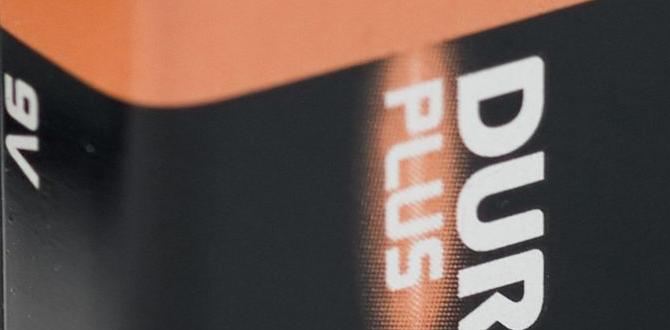Cheap hybrid car battery with longest life? Yes, it’s possible! Focus on reliable brands and proper maintenance. Get the most out of your hybrid battery investment with our expert guide, ensuring power and savings for years to come.
Are you worried about the cost of replacing your hybrid car battery? It’s a common concern, as hybrids are fantastic for saving fuel but can bring a big repair bill. But the good news is, not all hybrid batteries are created equal, and with the right choices and care, you can find a cheap hybrid car battery with the longest life. We’ll walk you through how to make smart decisions and keep your hybrid running smoothly without breaking the bank. Get ready to understand your options and feel confident about your hybrid’s power source!
Understanding Hybrid Car Batteries: What Makes Them Different?
Hybrid cars, like the Toyota Prius or Honda Insight, combine a traditional gasoline engine with an electric motor, powered by a special battery. This battery is the heart of the hybrid system, helping to boost acceleration and recapture energy when you brake. Unlike the small 12-volt battery in a regular car, hybrid batteries are much larger and more complex. They are designed to last a long time, often 100,000 miles or more.
These batteries are made up of many smaller cells working together. When one of these cells starts to weaken, it can affect the whole pack. This is why sometimes you hear about hybrid battery replacements. The technology has gotten much better over the years, and many hybrid batteries can go for a very long time with good care.
The Lifespan Expectation Game
So, how long can a hybrid battery really last? Most manufacturers offer warranties on hybrid batteries, typically for 8 years or 100,000 miles, and sometimes even as long as 10 years or 150,000 miles. Many drivers report their original hybrid batteries lasting well beyond these warranty periods, sometimes reaching 200,000 or even 300,000 miles! This longevity is a testament to the robust engineering, but it also depends on how the car is driven and maintained.
Several factors influence a hybrid battery’s life:
- Driving Habits: Frequent short trips where the battery isn’t fully charged or long, hard acceleration can stress the battery.
- Climate: Extreme heat or cold can impact battery performance and lifespan.
- Maintenance: Keeping up with general car maintenance, including cooling system checks for the battery, is crucial.
- Battery Type: Newer technologies, like Lithium-ion (Li-ion), are becoming more common and are often more durable than older Nickel-Metal Hydride (NiMH) batteries.
Finding a “Cheap” Hybrid Car Battery: What to Look For
When we talk about a “cheap” hybrid car battery, it’s important to define what that means. It doesn’t always mean the lowest upfront cost, but rather the best value for money over time. A battery that fails prematurely, even if it was cheap initially, ends up costing you more. So, a truly “cheap” hybrid battery with a proven long life is one that offers excellent performance and durability without an exorbitant price tag.
New vs. Remanufactured vs. Used Batteries: A Breakdown
When it’s time to replace your hybrid battery, you’ll likely encounter three main options:
New Hybrid Batteries
These are brand-new battery packs from the original manufacturer (OEM) or a reputable aftermarket company. They come with a full warranty and are built to the highest standards. While they offer peace of mind and the longest expected lifespan, they are also the most expensive option.
Remanufactured (Reconditioned) Hybrid Batteries
These battery packs have been taken apart, inspected, and repaired or rebuilt using new or refurbished components. Often, weak cells are replaced, and the battery is tested to ensure it performs like new. Remanufactured batteries can offer significant savings compared to new ones and often come with a shorter, but still respectable, warranty. This can be a great way to get a cheap hybrid car battery with longest life, as the core pack is often revitalized.
Used Hybrid Batteries
Pulled from salvaged vehicles, these batteries are sold “as-is.” They are the cheapest option upfront but also carry the most risk. Their remaining lifespan is uncertain, and they typically come with no warranty or a very limited one. For those on a strict budget, this might seem appealing, but the potential for premature failure and further repair costs makes it a gamble.
For the best balance of cost and longevity, remanufactured batteries are often the sweet spot. They’ve been revitalized, meaning they can offer a renewed lease on life, making them a smart choice for a cheap hybrid car battery with longest life.
Reputable Brands and Where to Find Them
Choosing a reputable brand is crucial for ensuring you get a battery that lasts. Look for companies that specialize in hybrid battery repair and remanufacturing. These companies often have years of experience and rigorous testing procedures.
| Battery Option | Pros | Cons | Typical Cost Range (USD) | Warranty |
|---|---|---|---|---|
| New OEM | Highest quality, longest potential life, full warranty | Most expensive | $2,000 – $5,000+ | 8-10 years or 100,000-150,000 miles |
| New Aftermarket | Good quality, competitive pricing, warranty | Quality can vary by brand | $1,500 – $4,000+ | 5-8 years or 60,000-100,000 miles |
| Remanufactured/Reconditioned | Significant cost savings, good lifespan, often has warranty | Lifespan can be slightly less than new, depends on rebuild quality | $800 – $2,500+ | 1-5 years or 12,000-50,000 miles |
| Used | Lowest upfront cost | Uncertain lifespan, high risk, often no warranty | $300 – $1,000+ | Usually no warranty or very limited |
When searching for a cheap hybrid car battery with longest life, prioritize companies that offer:
- Detailed testing procedures: Ask what tests they perform to guarantee the battery’s condition.
- Good warranties: A solid warranty is a sign of confidence in their product.
- Specialization in your car model: Some companies are better known for certain hybrid makes and models.
- Positive customer reviews: Look beyond their website to independent forums and review sites.
Popular aftermarket and remanufacturing companies include Dorman, GreenTec Auto, and local specialists. Always do your homework on the specific company and their offerings for your vehicle.
Maximizing Your Hybrid Battery’s Lifespan: Maintenance Tips
Even if you buy a new or remanufactured battery, how you treat it will significantly impact how long it lasts. Think of it like taking care of any valuable piece of equipment – a little attention goes a long way. These tips can help you extend the life of your hybrid battery, making your investment in a cheap hybrid car battery with longest life even more worthwhile.
Routine Checks and Vehicle Health
Your hybrid battery is often part of a larger system that needs regular maintenance. A healthy car supports a healthy battery.
- Cooling System: Hybrid batteries generate heat. Your car has a cooling system specifically for the battery pack. Ensure the battery’s cooling fans and vents are clean and unobstructed. A mechanic can check this during regular service. Debris or dust buildup can cause overheating, stressing the battery cells. You can often visually inspect the battery pack’s vents to ensure they aren’t blocked by leaves or dirt.
- Fluid Levels: While the hybrid battery itself doesn’t use “fluids” in the traditional sense, the car’s other systems do. Proper coolant levels, for example, contribute to overall vehicle efficiency, which indirectly helps the hybrid battery manage its workload.
- Tire Pressure: Underinflated tires create more drag, making the engine and electric motor work harder. Keeping tires properly inflated helps everything run more efficiently, reducing strain on the battery. Check your tire pressure monthly. For guidance on tire pressure, visit NHTSA’s tire safety page.
Driving Habits That Matter
The way you drive has a direct impact on your hybrid battery’s stress levels.
- Gentle Acceleration: Avoid sudden, hard acceleration whenever possible. Gradual acceleration allows the electric motor and gasoline engine to work together more smoothly, putting less demand on the battery.
- Smooth Braking: Hybrid vehicles are designed to recapture energy during deceleration. Smooth, gentle braking helps maximize this regenerative braking process, which recharges the battery. Avoid hard braking unless necessary.
- Avoid Constant Short Trips: If possible, try to combine several short trips into one longer one. This allows the battery to reach optimal operating temperature and discharge/recharge cycles more efficiently. Constant stop-and-go on very short trips can stress the battery.
- Minimize Idling: While hybrids are efficient at idle, prolonged idling when the battery isn’t actively engaged to move you can be less beneficial.
Seasonal Considerations
The weather plays a role in battery performance.
- Extreme Heat: High temperatures can degrade battery components faster. Parking in the shade or using a sunshade can help keep the car cooler. While the car’s cooling system works hard, reducing external heat exposure is always beneficial.
- Extreme Cold: In very cold weather, the battery might not perform at its peak efficiency immediately. The gasoline engine may run more often to help warm up the battery and cabin. This is normal, but avoid pushing the car hard until it’s warmed up.
DIY vs. Professional Hybrid Battery Replacement
Replacing a hybrid battery is a more complex job than swapping out a standard 12-volt car battery. It involves high-voltage systems that can be dangerous if not handled properly. For this reason, professional replacement is generally recommended.
Why Professional Replacement Is Safer
Hybrid battery packs contain high-voltage components that can deliver a severe or even fatal electric shock if not handled with extreme caution and specialized training. Professional mechanics and technicians at hybrid battery service centers:
- Have the necessary safety equipment, including insulated tools and protective gear.
- Are trained in the procedures for safely disconnecting and removing high-voltage components.
- Can properly diagnose whether the entire battery pack needs replacing or if individual modules can be repaired or replaced.
- Know how to dispose of old batteries responsibly, as they contain hazardous materials. Many states have regulations around this. For example, California has specific rules for battery disposal. You can find more information on waste management from resources like the EPA’s electronics recycling guide, which covers batteries.
When DIY Might Be (Carefully) Considered
For some technically inclined individuals, there might be a desire to attempt some aspects of hybrid battery service. However, this is rarely recommended for the complete pack replacement itself. In some niche cases, DIY might involve:
- Cleaning Battery Vents: As mentioned in maintenance, ensuring vents are clear requires no special tools and can be done safely.
- Replacing an Engaged Fob Battery: This is a standard 12-volt battery used for your car key, not the hybrid drive battery.
Important Safety Warning: Never attempt to open a hybrid battery pack or disconnect its main high-voltage leads unless you are a certified professional with the correct safety equipment. The risk of serious injury or death is very high.
When budgeting for replacement, factor in the cost of professional labor. This cost, combined with a quality remanufactured battery, often represents the best path to an affordable, long-lasting solution for a cheap hybrid car battery with longest life.
Common Hybrid Battery Warning Signs and Symptoms
Your car is pretty good at telling you when something is wrong. Hybrid battery issues often don’t happen overnight; they usually give you some warning signs.
What to Watch Out For
- Reduced Fuel Economy: Your hybrid starts using more gas than usual. This is one of the most common indicators that the hybrid system isn’t working as efficiently as it should.
- Battery Warning Lights: The dashboard indicator lights for the hybrid system or the check engine light will illuminate. Don’t ignore these!
- Loss of Power: The car feels sluggish, especially during acceleration or when climbing hills. The electric motor might not be providing its usual boost.
- Intermittent Electric-Only Driving: The car spends less time running solely on electric power in stop-and-go traffic or at low speeds.
- Engine Running More Than Usual: The gasoline engine kicks in more frequently or for longer periods, even when you expect the electric motor to handle it.
- Unusual Noises: While less common, sometimes a failing battery pack can produce strange sounds.
If you notice any of these symptoms, it’s wise to get your hybrid system checked by a qualified technician. Early diagnosis can prevent minor issues from becoming major, expensive repairs. It might be something simple like a weak cell that can be replaced, or it could indicate the need for a full battery pack, where choosing a remanufactured option becomes key to finding that cheap hybrid car battery with longest life.
Case Study: Extending Hybrid Battery Life on a Budget
Let’s look at an example. Sarah drives a 2010 Honda Insight that’s approaching 150,000 miles. She started noticing a dip in her usual fuel economy and a slight sluggishness on inclines. Her mechanic confirmed that one of the hybrid battery modules was weakening. A full new battery pack would cost over $3,000.
Sarah, however, wanted a more budget-friendly solution that could still last. She researched companies that specialized in remanufacturing hybrid batteries for her specific car model. She found a reputable shop that offered a remanufactured battery pack with 30 new hybrid-specific cells and a 2-year warranty for $1,500, including installation. This was significantly cheaper than a new battery.
She also committed to following the maintenance tips: ensuring the battery vents stayed clean and driving more smoothly. Six months later, Sarah reported that her fuel economy was back to normal, the car felt responsive, and she was confident she had found a cheap hybrid car battery with longest life for her needs. She avoided the high cost of a new battery while still getting a reliable, warrantied solution.
Frequently Asked Questions (FAQ) about Cheap Hybrid Car Batteries
Q1: Can I really find a “cheap” hybrid car battery that lasts a long time?
Yes! The key is to look for high-quality remanufactured batteries from reputable specialists. These batteries have been rebuilt with new or refurbished components and tested, offering a good balance of reduced cost and proven longevity compared to brand-new OEM batteries.
Q2: Is it safe to buy a used hybrid battery?
Buying a used hybrid battery is risky. While it’s the cheapest option upfront, there’s no guarantee of its remaining lifespan or performance. These batteries are often sold “as-is” with little to no warranty, making them a gamble that could lead to more expensive repairs down the line.
Q3: What are the most common signs my hybrid battery is failing?
Common signs include a noticeable drop in fuel economy, the hybrid system or check engine warning lights illuminating, a loss of power or acceleration, and the gasoline engine running more frequently than usual.
Q4: How long do hybrid batteries typically last?
Most original hybrid batteries last well beyond their warranty periods (often 8-10 years or 100,000-150,000 miles), with many reaching 200,000-300,000 miles. Remanufactured batteries, if well-built and maintained, can also provide many years and miles of service.
Q5: Why is replacing a hybrid battery so expensive?
Hybrid battery packs are complex, large, and contain many individual cells. The specialized technology, intricate packaging, and high-voltage safety protocols required for their manufacturing and replacement contribute to their cost. However, remanufactured options offer significant savings.





